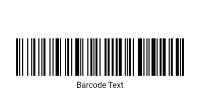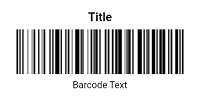Code 128B is a versatile and highly efficient barcode symbology within the Code 128 family, designed to encode a wide range of characters, including uppercase and lowercase letters, numbers, and a variety of symbols. This makes it ideal for applications requiring detailed and complex data encoding in a compact form.
Developed in 1981 by Computer Identics, the Code 128 symbology was created to provide a robust solution for high-density alphanumeric encoding. Code 128B, one of the three subsets of Code 128, specifically includes a broad character set that covers the full ASCII range, making it suitable for diverse applications.
Technical Specifications
Code 128B can encode all 128 ASCII characters, which include uppercase and lowercase letters, numeric digits, and various punctuation and control characters. Each character in Code 128B is represented by a unique pattern of bars and spaces, with the entire barcode including start and stop characters, encoded data, and a modulo 103 checksum for error detection.
The structure of a Code 128B barcode begins with a start character (START B) that signifies the beginning of the data encoded in Code 128B format. The data characters follow, each represented by 11 modules comprising three bars and three spaces of varying widths. The barcode ends with a stop character, ensuring scanners can accurately detect the end of the barcode.
Checksum Calculation
The checksum in Code 128B is calculated to ensure data integrity and involves the following steps:
- Assign a unique value to each character based on its position in the character set.
- Multiply each character’s value by its position in the sequence, starting with the start character assigned a position value of 1.
- Sum these products.
- Divide the total sum by 103 and use the remainder as the checksum value.
- Append the corresponding character of the checksum value to the end of the data before the stop character.
This modulo 103 checksum significantly reduces the chances of read errors, ensuring high data accuracy.
Code 128B Applications
Code 128B is used extensively across various industries due to its flexibility and high data density. Common applications include:
- Logistics and Shipping: Encodes detailed shipping information, tracking numbers, and other relevant data, ensuring accurate and efficient package routing and delivery.
- Inventory Management: Facilitates detailed item identification and tracking in warehouses and retail environments, improving stock control and management.
- Healthcare: Used for patient identification, medical records, and medication tracking, ensuring accurate and secure data handling.
- Retail: Encodes product details, pricing, and other information, streamlining the checkout process and inventory tracking.
Advantages and Disadvantages
Code 128B offers several advantages, including its ability to encode a comprehensive set of characters, making it highly versatile. Its compactness allows it to store large amounts of data in a small space, which is essential in environments where space is at a premium. The inclusion of a checksum ensures high data integrity and accuracy during scanning.
However, Code 128B can be complex to encode and decode, requiring sophisticated scanners and software. Additionally, while it is very dense, this can sometimes make it more challenging to print and read, especially on less smooth surfaces or lower quality prints.
Comparison with Other Barcode Symbologies
Code 128B stands out for its high data density and versatility compared to other barcode types. Unlike Code 39, which is also alphanumeric but less compact, Code 128B can encode the full ASCII character set in a more space-efficient manner. Compared to UPC or EAN codes, which are primarily numeric and used for individual retail items, Code 128B offers a broader range of applications due to its ability to encode complex and varied data types.
Code 128B is a powerful and flexible barcode symbology ideal for applications requiring the encoding of a diverse range of characters in a compact form. Its development has enabled significant advancements in data accuracy and efficiency across various industries, from logistics and inventory management to healthcare and retail. While it requires more sophisticated technology to implement, the benefits of its high data density and error detection capabilities make it a preferred choice for complex data encoding needs.


